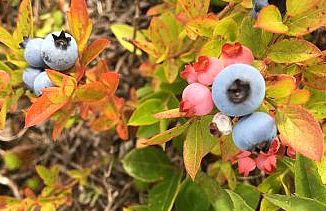Let's Get Blueberries: Conservation Practices
by Luis Aponte

Wild blueberries have become part of the culture of Maine. It seems like they have been around forever, and every year people are more and more encouraged to consume this fruit fresh for its health benefits (antioxidant, anticarcinogenic, etc.) Maine is the top producer of wild blueberries in the country, consisting of around 44,000 acres of production.
What is most incredible about this crop is that most of the fields occurred naturally and were discovered hundreds of years ago. As the years have gone past, and production of these has become widely important, the cultural practices have changed. Now production has been established as a two-year cycle, one for growth and one for harvest.
Once the harvest is done, plants are pruned so they start their vegetative growth cycle again. Traditionally, farmers have used burning as their pruning technique. More recently, as a way to reduce emissions and protect air quality, farmers have been encouraged to mow these fields.
But before pruning, farmers have to remove the rocks and boulders from the fields. Since wild blueberries were some of the first plants to appear after the glaciers receded, these rocks were left standing in these fields and are one of the reasons that farmers burn, as a way to work around them. These rocks can cause major problems for mowing equipment, and it is better to take them out ahead of time.
It cannot be denied that burning has its advantages, as the incidence of pests (insects, diseases) is lower. But mowing presents some incredible advantages of its own. Most people who burn their fields use flammable oil, and the price of oil these days is not a pretty sight to look at. Plus every acre of blueberry crops burned consumes around 80 gallons of flammable oil, pretty high price for a farmer to incur every two years.
Mowing presents a great opportunity for farmers to reduce their cost of pruning. Additionally, by mowing farmers can take advantage of the removed vegetation to increase the organic matter of the soil, thus promoting a healthier environment for the new stems to grow in.
Truth be told, pest management has to be more intensive when the stems are mowed. The farmers have to be much more perceptive to issues like mummyberry, blight and insects including the blueberry maggot and flea beetle. However, with a good scouting system and enough monitoring this should not be a problem. As long as these pests are detected early on, they can be managed/ sprayed as needed. Even with its greater management level, mowing makes for a healthier and more environmentally friendly system.
Blueberry plants spread throughout the field as rhizomes that branch out of the mother plant, which is also known as a clone. Each of these clones will be different, and an average clone can cover up to 250 square feet of land. As these rhizomes spread, the field will be covered more evenly. The spread of rhizomes throughout the field will increase the production and can sometimes even double the average production values.
There has been extensive research on how to promote these rhizomes to spread more rapidly, and as some of the techniques involve maintaining soil health and nutrient management, there is a conservation practice that stands out. Mulching has proved to be an important practice in the production of blueberries. By mulching, farmers are creating an environment that greatly improves conditions for these plants to spread evenly and be healthy. Mulching not only increases soil organic matter, but also moderates soil temperature, increases soil moisture, protects plants from frost heaving and reduces soil erosion.
There are various types of mulch that farmers can use, from sawdust to bark. But the vast majority of farmers use wood chips, as they are cost effective and easy to find. It has become a very important practice inside the blueberry community, and its increased use has helped farmers achieve greater yields.
There are some other conservation practices that could help blueberry farmers maintain a healthy environment and keep the plants productive and healthy. Pollination is very important in blueberries, and the establishment of a native pollinator habitat can help increase yields. Soil erosion in blueberry fields is a big concern, especially in farms with little cover and steep slopes. To address erosion issues lined waterways can be established to slow down the flow of water and reduce soil loss.
Establishing an integrated pest management plan can reduce the use of chemicals and develop a more efficient system to deal with pests. There are many more, but the general idea is to work in the most environmentally friendly way to make the land more productive and the operations more efficient.
The practices identified this week's guest columnist, Luis Aponte, are equally valid for landowners considering ways to manage their property and the stormwater erosion that may occur there. Plus you learn more about wild blueberries!
Now retired, Dale Finseth was executive director of the Kennebec County Soil & Water Conservation District from 2001 to 2024.
<— Previous Article • Summaries • Next Article —>
©2020 by Summertime in the Belgrades. All rights reserved.

